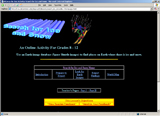Search For Ice And Snow
Using an Earth Image database (Space Shuttle images), students try to find places on Earth where there is ice and snow. For some communities, water is not a problem. But some areas in the world are arid or prone to droughts. For people living in those places, where to get water is crucial. In some arid areas, water can come from snow an ice found on nearby high mountains or at extreme latitudes.
Key Questions
1. What regions of the world have ice and snow?
2. How can you determine whether a region in the world has ice and snow?
Learning Objectives
1. Students will be able to express ideas about where there is ice on the Earth and why.
2. Students will be able to find WWW images of Earth and download them.
3. Students will be able to determine ways to distinguish areas of ice/snow from clouds or other white features on images of the Earth.
4. Students will be able to use world maps to mark places were they find ice and place the names of locations and/or coordinates where possible.
General Subject Areas
Earth Science, Geology
|
 Author: Alan Gould
Author: Alan Gould
VIEW THE LESSON
Student Activities
Students, using the web and world map, will identify the regions of the world which receive and collect snow. Students will report where they found the information, geographic location of the ice, latitude, longitude, and any other pertinent information. Students will present this information to the teacher.
Student Prerequisites
Familiarity with any efficient web browsing tool; basic map reading capability; understanding of latitude and longitude is required for students to be able to pinpoint locations on the Earth map. Ability to download and print images is helpful.
Assessment
Have students submit their lists of snow/ice locations, with verification. Next, find a particular image that has an especially interesting land feature in it and challenge students to find the image from specified coordinates and identify what the feature is.
Extended Learning
Available on lesson plan pages- students are encouraged to explore ice and snow on other planets and make comparisons.
|
View Teacher Feedback
Send Us Your Feedback
Time Requirements
Approximately 30 minutes prep time and one or two class periodes for the activity.
Materials Required
-Internet connected computer with WWW browser program
-Paper and pencils
-A copy of the online world map (supplied online) for each student or group
Required Plugins
N/A
Additional Resources
Teacher Lesson Page
Best For Grades
middle/high school
National Science Education Standards (NSES)
grades 5-8
grades 9-12
State Science Standards
Grade 5 Earth Sciences
Grade 6 Plate Tectonics and Earth's Structure
Grade 8 Physical Science
Grades 9-12 Earth Sciences
Have a science question? Visit our Ask an Expert page. Email questions or comments about SEGway resources to: outreach@ssl.berkeley.edu
|












